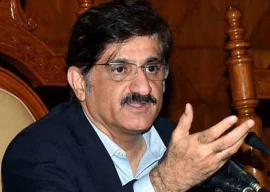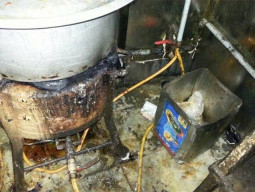
The marines and army are taking us to a kachcha area about 30 kilometres from Lansdowne Bridge in Sukkur. The gangly jawans with big feet are passing sacks of relief goods in an assembly line onto the hovercraft that sits, deflated, on the bank of the River Indus. As we prepare to leave, we are told to stand back as the pilot inflates the bottom. Amid the whirring roar and whip of sand, a feint-hearted colleague runs behind me, grabs my shoulders and rams the top of his head in between my shoulder blades, cowering in what I would not want to describe as fear. The jawans standing around snicker. It’s not every day that they get to see a grown man hide behind a woman wearing pink.
Once the hovercraft’s hull has ballooned, we climb on, with the help of a straight-backed chair, the kind you sit on at weddings. One member of our team slips because he accidentally tried to get a leg up on the rubber bottom. The pilot winces. “You’re not supposed to do that,” he moans.
Once inside we speed along parallel to a levee after turning left from Lansdowne Bridge, which hovers like a lace-work of iron and steel between Sukkur and Rohri. Being on a hovercraft is pretty much the same as being on a boat, except that our pilot is a handsome green-eyed Lt Faisal, who’s been doing this for three years and has the air of young man with a big toy.
He sits at the head of the hovercraft, behind a tight small steering wheel. The Griffon 2000TD(M), which needs 880 litres of diesel, was made by the British, is left-hand drive and the marines have four of them. “It’s made me a better driver on land,” he says, his left arm casually, ever so coolly, slung out of the window, much like the young guns who whizz about Zamzama. To his right, on the dashboard, is an ashtray. He likes to take long drags at a cigarette.
We head straight to the kachcha area, which is basically a muddy stretch along the river, notorious for being inhabited by dacoits. The hovercraft is greeted by a handful of people at the shore. Their feet are caked with boots of mud, their loongis and shalwars are hitched above the knee and one of the men, whose waistband is just a tug away from a groinful of nudity, is sporting a giant silver watch.
A few members of the team head into the muck to talk to the families after the packets of food are distributed. The army men start to panic when the Express members disappear behind the bushes. “They have no idea what this area is like,” says the ISPR man who’s babysitting us. There are a few jokes about leaving them here if something bad happens or letting them swim back. But by the end of 15 minutes the pilot is starting to sweat. “I can’t waste this fuel,” he grimaces. A few phone calls are made, first asking, then pleading and then “ordering” them to turn back. The last thing we want is a kidnapped journalist. On earlier missions, says Lt Faisal, they were shot at from all sides by suspicious people.
On the way back, we wave to people on the embankment and they wave back, as if none of the flooding happened and someone went on a picnic. Some of the children are excited to see the hovercraft. One jawan with an AK47 whose stock is duct taped together, waves at them like a two-year-old. When we reach the shore, the men in fatigues stand for the photo-op. The hovercraft’s bottom is deflated. We thank them for the ride.
Published in The Express Tribune, August 27th, 2010.

















COMMENTS (1)
Comments are moderated and generally will be posted if they are on-topic and not abusive.
For more information, please see our Comments FAQ